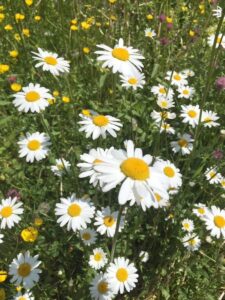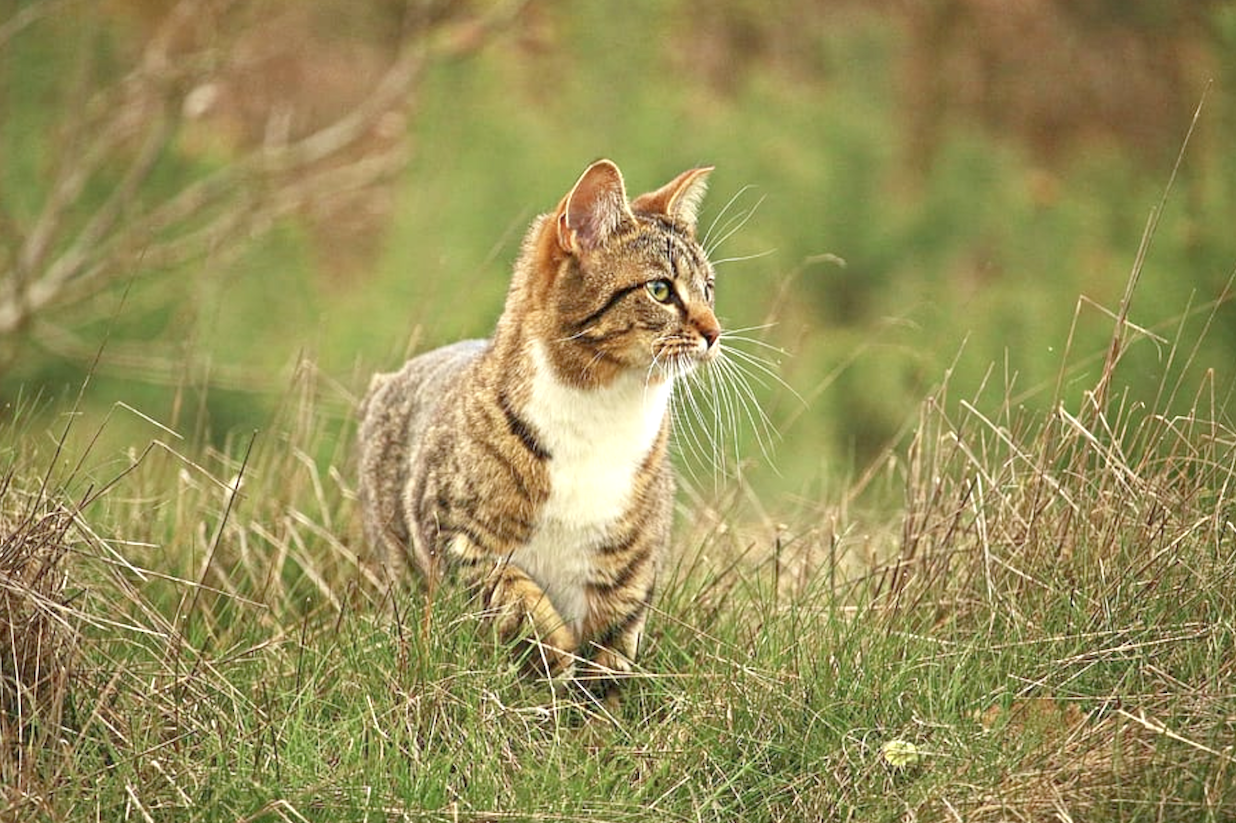By Lila Hartelius
This morning, while I was sitting in my yard reading John R. Stilgoe’s foreword to Gaston Bachelard’s The Poetics of Space, the soft, insistent coo of a chicken made me turn my head. A reddish hen was descending the tree-sheltered slope of a neighbor’s chicken enclosure. “Hello,” I cooed back, probably sounding more like I was talking to a baby than to a bird.
A few minutes later, a neighboring tabby cat came slinking along the fence opposite the enclosure. It picked its way over dirt clods, casting frequent glances down into a forest-y undergrowth area I’d seen it trot away from a few days earlier, clutching a tiny rodent in its mouth. When I finally said, “hello,” with similarly whimsical enthusiasm, it whipped its head around to stare at me with wide, matte green eyes before looking away and continuing its watch.
By the time another neighbor’s dog pranced into view a few moments later in its front-yard universe, playing with anything it could pretend to animate with a paw stroke, it had become clear to me: the start of the COVID-19 lockdown in my area had marked the beginning of a period of greatly reduced contact with other humans, yet I was definitely not alone.
This was not the first time I’d felt a sense of warm company in the presence of the fauna and flora of a place. The night I arrived at the little apartment that would be my shelter during my first visit to a forest in Central America, I stepped out onto the back patio and found myself shrouded in a living, singing amalgam of twisting tree arms reaching down toward me with dusty leaf-hands twice the size of my own, emerging from the thick of a night infused with the chanting of a million cicadas.
Knowing this habitat was rife with animals and bugs—many of which I suspected I was yet to encounter—I expected to feel the forest closing in on me with a thousand spine-tingling eyes I couldn’t see to distinguish friend from foe. Instead, I sensed my surroundings yelping a celebratory “hi!” like a wide-eyed child beaming with joy and curiosity in an era that comes before it learns to fear other humans.
I remember that era. A perfect stranger, in the right circumstances, could become a conversation partner for the space of a meandering exchange about whatever happened to come to mind. Looking back on that time now makes me both retrospectively fearful for my child-self and wishful I had that boldness now to accompany the adult wisdom I’ve since acquired.
For most of my life, I’ve been “sauvage.” This French word literally translates to “wild” as in “untamed” but is also understood to refer to someone who is particularly shy or who avoids social contact more than most humans. The technical term for what I experience in this regard would probably be “social anxiety,” but it’s more pleasing to imagine myself as a sometimes-tameable wild animal that tends to keep its social distance from most humans. The fauna and flora of this planet have kept me company for as long as I can remember. They’ve been there since before the anxiety crystallized in me, and they’re a sustaining force that’s carried me through my days and nights ever since I began to learn to feel apprehensive toward humans.
Unfortunately humans have taught me to fear “nature” too, as if life, instead of being something I’m a part of, were something precious and singular I must hold onto in the face of unpredictable forces “out there.” This has undoubtedly contributed subconsciously to me staying indoors excessively. This resistance to going outside often simply feels like plain overwhelm, as if I were expecting all flora to spot me and say, “Come look at my flower! Come touch my leaf! Come wade in our swaying sea of green!” This wouldn’t be so bad if it weren’t followed by a second wave of berating thought-reflexes tugging at my mind just as the flora’s imploring enthusiasm tugs at my heart: Be careful where you walk—there are nettles out here … No way—last time you laid down in the grass you got bed bugs … What if a tick falls on you from these trees? Whatever the reasoning for staying indoors, it seems fueled by an underlying feeling that the outside world—both human and non-human—is teeming with risks.
So, it was with difficulty at the end of a long day yesterday that I parted with the tempting idea of curling up in my reading nook with my chosen book of the evening and, instead, took my hardcover companion outside with me to read in what disappointing light was left in the dusk that remained after I’d procrastinated through sunset. Though the air had cooled, I set my bare feet on the ground, breathing in deeply the freshness that always makes stepping outside worth it. Regularly getting barefoot contact with the earth does wonders for calming my mind and helping me feel I actually have a physical body—both of which have been otherwise hard for me to achieve to any significant extent.
So, there I was with my feet in the grass this morning, reading Stilgoe’s foreword as I waited for my mind to gather itself and my body to show up on my mind’s register as an inhabitant on this planet. “To imagine living in a seashell,” I read, “to live withdrawn into one’s shell, is to accept solitude” (Stilgoe viii). The choice of the word “accept” struck me as an expression of resignation, filling the word “solitude” with a hollow sadness the color of waning crepuscular gray seeping from the inside of an empty amphora.
Yet it was the word “withdrawn” that had first captured my attention. The relief I experienced when reading it was akin to what I’d felt the previous evening while entertaining the idea of diving into my reading nook. It was in stark contrast to the lonely amphora feeling I had. The moment of welcome retreat I denied myself yesterday for the sake of getting regular fresh air during this long period of confinement was, I realized, a microcosm reflection of the relief I’ve been feeling at not having to venture out into the social world.
“To imagine living in a seashell,” I read again, “to live withdrawn into one’s shell, is to accept solitude—and to embrace,” I read on, “even if momentarily, the whole concept and tradition of miniature, of shrinking enough to be contained in something as tiny as a seashell, a dollhouse, an enchanted cottage” (Stilgoe viii-ix). “Yes! Yes!” my soul cried as it leapt in my chest: to be contained, to let myself collapse back down to human size after months—years—of trying to expand beyond my own limits to be part of this human world with its sometimes strange social customs, from which I try desperately to extract a few drops of the nectar of meaningful human connection – all the while dancing right around it to avoid stepping on anyone’s toes. “Me-size” looked and felt welcomingly miniature in a world in which, I realized, I’d been trying to be larger than life.
While it has more often been with fauna and flora that I’ve felt—as I did in my yard this morning and in the forest that night in Central America—a sense of meaningful connection that might be called community or being part of a larger whole, there have also been moments when I’ve felt this in relation to humans (after all, as humans, we, too, are fauna). One such instance happened, paradoxically, at the start of the lockdown.
Walking down a street near my house for some exercise as day calmed into dusk, I saw lights in windows of houses and people preparing dinner. Well aware they might be griping about new restrictions on their movement, I, by contrast, felt a peculiar comforting warmth in my chest. I didn’t know who lived in those houses, and the people in them might have been home that evening anyway even if there weren’t a lockdown. But the idea that, for a period of time, all of us would be around, here in this neighborhood, filled the place with a sense of presence and cocooned me in a quiet feeling of belonging.
For the rest of that walk, my little corner of the world felt truly inhabited, interconnected by simple activities of human life even as structural walls separated those individuals or households partaking in those activities. Individualistic interests and commuter imperatives had suddenly been put on hold. In that moment, the houses up and down the street became, in my mind, not just boxes for their inhabitants to sleep and eat in but metaphorical hearths where those inhabitants might re-collect a sense of deeper connection to a whole comprising fellow humans, other fauna, and flora—a whole that might be called “home.”
Lila Hartelius, BA (lilahartelius.wordpress.com) is a bilingual (English/French), published writer who has served as editorial assistant for the International Journal of Transpersonal Psychology. Her work has been published in Bi Women Quarterly, Weird Sisters West and Tendrel (Naropa University’s diversity journal). She has been a workshop leader at EuroBiCon and has contributed to the efforts of Bennington College’s Queer Student Union, Naropa University’s GLBTQ student group, and Boulder Pride.
Work Cited: Stilgoe, John R. Foreword. The Poetics of Space, by Gaston Bachelard, 1958, translated in 1964 by The Orion Press, 1994 ed., Beacon, 1994, pp. viii-ix.

Photo by Casey Lawrence

